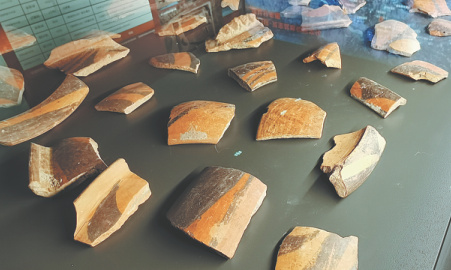

It seems to me that the adobe house had been subject to a high temperature lasting for days. Similar houses have also been found in Yangshao Culture and its contemporary neighbors. Yet, consensus has not been reached on the reason why these adobe houses were torched.
The clear-cut boundary invited me to speculate that the four walls of the house might have been intentionally pushed down from outside after a duration of firing.
The interior space of the house was divided into three compartments.
Lots of painted pottery shards were recovered during the excavation. Unfortunately, most of them cannot be pieced together. People might have removed all the utensils when they decided to leave the house and burn it.
Before the excavation at Dobrovat, I also bore the same romantic ideas as Andersson. However, after two months of fieldwork and multiple trips to local museums, I gradually realized that visual similarities on the surface of pottery are superficial and even misleading, because they divert our attention from the key cultural indicators hidden behind these similarities.
The macro historical processes of these prehistoric cultures are more intriguing to me. For example, both cultures emerged and flourished in the transitional era from the Neolithic to the Bronze Age; they developed grain farming as the major strategy of subsistence and economy; and they both underwent waves of cultural expansion, driven by the growth of the agricultural population.
Even thousands of kilometers apart, developmental trajectories of Cucuteni and Yangshao run strikingly parallel to each other, making up the earliest community of fate at both ends of the Eurasian continent. We can only fully appreciate the most unique advantages of the discipline of archaeology, when a subject is being considered in the framework of a community of fate over a long period of time and on a transcontinental scale.
Certainly, answers to these questions still depend on the continuity of fieldwork after international travel restrictions, imposed by COVID-19, are finally lifted.
Wang Kaihao contributed to this story.